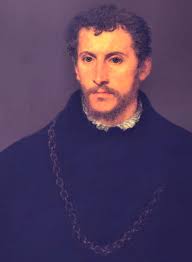
Summary: Edmund Campion S.J. spent some time in Ireland in the 1560s. Later went to the English College in Douai and from there walked on pilgrimage to Rome where he joined the Jesuits.
 Edmund is one of the best known of the Forty Martyrs of England and Wales who were were canonised by Pope Paul VI in Rome on 25th October 1970.
Edmund is one of the best known of the Forty Martyrs of England and Wales who were were canonised by Pope Paul VI in Rome on 25th October 1970.
Patrick Duffy presents the historical context of the martyrdoms and a list of the forty martrys.
When King Henry VIII, after his break with Rome, proclaimed himself supreme head of the Church in England and Wales, Catholics felt that he had usurped a supremacy in spiritual matters that belonged only to the Pope. While they wished to remain loyal subjects of the Crown as the legitimately constituted authority, they refused for reasons of conscience to recognise the “spiritual supremacy” of the King.
When the Act of Supremacy was passed in 1534, it quickly led many having to face a serious dilemma and even death rather than act against their conscience and deny their Catholic faith. It is important from the ecumenical point of view to note that these deaths were not the result of internal struggles between Catholics and Anglicans. It was rather that those who died were not willing to submit to what they saw was an illegitimate claim of the State.
Four waves of persecution against Catholics
The martyrdoms involving the Forty Martyrs of England and Wales span the years from 1535 to 1679. Four distinct waves of persecution are discernible.
The first followed the passing of the First Act of Supremacy (November 1534) when Henry VIII broke with Rome and suppressed the monasteries. John Fisher, Bishop of Rochester, and Henry’s former chancellor, Sir Thomas More, were executed in 1535 along with a number of religious.
The second wave came after 1570 when Pope Pius V, believing that Queen Elizabeth I as the daughter of Anne Boleyn was illegitimate and had no right to the throne of England, issued a papal bull Regnans in excelsis excommunicating her and absolving all her subjects from allegiance to her and her laws. This was a real dilemma for Catholics especially if they were asked the “bloody question”: if there was an invasion from the Pope, which would you support – Rome or England? The numbers of Jesuits coming in from the continent were seen as a real threat to the Queen and the realm. In 1581 an Act was passed that made it treason to withdraw English subjects from allegiance to the Queen or her Church and in 1585 the entrance of Jesuits into the country was prohibited by law. A number of Jesuits, secular priests and lay men and women were executed at this time.
The third wave of persecution followed the failed Gunpowder Plot in 1605. This was a somewhat unwise attempt by number of Catholics to kill James I in a single attack by blowing up the House of Parliament during the ceremony of the State opening.
The final wave came in 1678 following the so-called “Popish Plot” created by the infamous Titus Oates. Oates had been twice expelled from Jesuit colleges on the continent and was refused admission as a novice. He spread the rumour that the Jesuits in collusion with the Pope were plotting to overthrow King Charles II and make England a Catholic country again. The very rumour of a plot was enough to stir a new persecution of Catholics.
The history of the cause
In 1850 when the Catholic hierarchy of England and Wales was reconstituted, the cause of almost 300 martyrs was introduced at Rome. Almost 200 of these were beatified by Leo XIII and Pius XI. Cardinal John Fisher, Bishop of Rochester, and Henry VIII’s chancellor, Sir Thomas More, were canonised in 1936.
In the Consistory of 18th May 1970, Pope Paul VI consulted the cardinals and announced that he would canonise the Forty Martyrs of England and Wales on 25th October 1970. The forty canonised that day were considered, after More and Fisher, the most representative from the original list of almost three hundred. Each of these forty martyrs has their own day of memorial, but are remembered as a group on 25th October.
Who are the forty martyrs?
The group comprises:
3 Carthusians:
1 Augustinian friar: John Stone d. 1538
1 Brigittine priest: Richard Reynolds d. 1535
2 Franciscans:
3 Benedictines:
10 Jesuits:
13 Priests of the Secular Clergy:
7 members of the laity(4 men & 3 women, all of women were mothers):